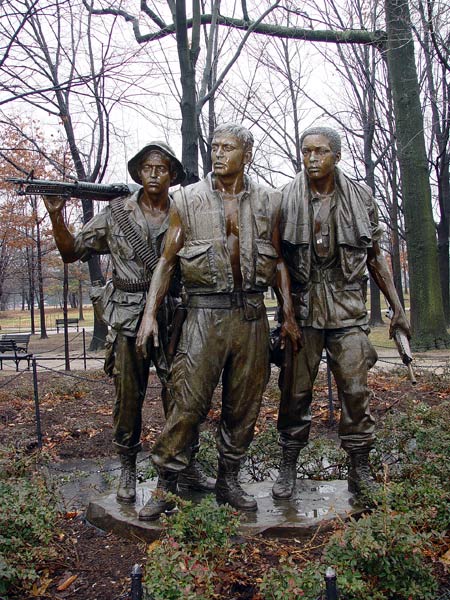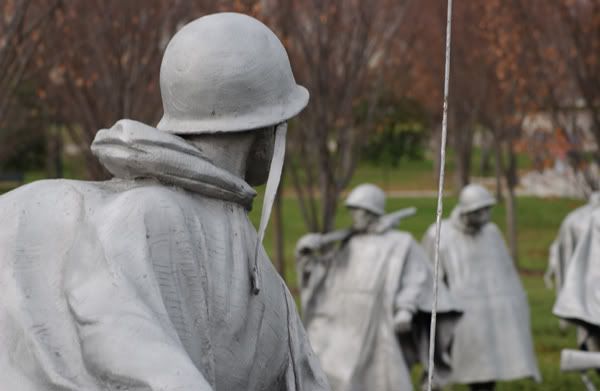Skip to comments.
Now, Memory Fails Us: A critique of D.C.'s memorial monuments
Washington Post ^
| May 28, 2006
| Paul Richard
Posted on 06/05/2006 8:46:07 AM PDT by Republicanprofessor
Something Has Gone Terribly Wrong With the Statues of Monumental Washington.
Remember, tomorrow's Memorial Day. That's what it's for, remembering.
The holiday's gone blurry. Now it's mostly fun (ballgames, setting up the barbecue, another day off work), but it used to be for focused recollections of the dead.
...
The fallen mustn't be forgotten. We used words like "the fallen" then. That seriousness bred art. That art would shape the country's look, and Washington's especially. Vast amounts of money, artistry and effort would be expended on its making. The beauty of the art would illumine its high purpose -- to immortalize remembrance. Strewn flowers weren't enough. The fallen would be given stone-and-metal monuments impervious to time.
....
Washington is filled with them. If you want to get Memorial Day, look around at the memorials. They're victors' monuments. They put generals on pedestals, and dead presidents above them.
...
They represent an art movement, now dead. For a long time their architects and artists, their stone-carvers and bronze-founders got better and better. For a long time their elevated style got nobler and nobler. Then, suddenly, it died.
It died a poignant death -- at the peak of its accomplishment, just when it got great. We know the date exactly. Memorial sculpture's greatness left Washington forever on the 30th of May, Memorial Day, 1922.
(Excerpt) Read more at washingtonpost.com ...
TOPICS: Arts/Photography; History; Military/Veterans
KEYWORDS: art; lincoln; memorial; monuments
This is a long article which evaluates the power and quality of many memorial monuments in Washington: from the powerful image of Lincoln to the lesser works of Kennedy and Roosevelt.
To: Republicanprofessor
The big problem is the limit on space on the mall and surrounding areas.
To: Republicanprofessor
The one monument that is not discussed is the Vietnam Memorial, which I thought the author would say was the last great hurrah of the monuments. I was wrong; that wasn't what he said.
But I think it is one of the greatest monuments, and for this reason: each visitor essentially walks and mourns through the war in miniature as one walks through the memorial.
At first the names of the 58,000 killed are low and few in number, but they rise as the war escalates. In the highest corner, one faces a black marble wall of hell, seeing one's own reflection therein, and you feel an emotional parallel to the deaths lost at the peak of the war.

a photograph by Hiroshi Watanabe of Maya Lin's Memorial
Then, as you walk outwards again, you seem to rise to the land of the living again.
It is made even more powerful by the momentos left for those who died.
Few memorials have you experience the war; usually you look at a general rearing on horseback (a motif derived from the Renaissance). I think Maya Lin's memorial work is much stronger because of the grave-like experience of the viewer there.
This might have been one of the most protested monuments, probably because of the ostensibly minimal form and because of the Asian name of the artist. Thus the erection of the three other realistic figures returning from a task in the field. They are more traditional and are not necessarily a bad addition, but they are not nearly as emotionally powerful as the Vietnam Memorial itself.

I did not see this article last week, or I would have posted it in a more timely manner.
To: Republicanprofessor
http://www.freerepublic.com/focus/f-chat/1534723/posts
Charles Atherton ran this area in Washington DC for many years.
Man Struck by Car, Ticketed Later Dies
AP via TBO ^ | December 5, 2005
WASHINGTON (AP) -- A 73-year-old man who received a $5 jaywalking ticket after he was struck by a car later died from his injuries, police said Monday.
Charles Atherton, a former secretary of the U.S. Commission on Fine Arts that advises the government on architecture and design in official Washington, was hit Thursday while crossing busy Connecticut Avenue. He died Saturday night at George Washington University Hospital.
Although witnesses said he was badly injured and unresponsive at the scene, police issued him the ticket. His family found it with his belongings when they went to the hospital.
To: Sam Cree; Liz; Joe 6-pack; woofie; vannrox; giotto; iceskater; Conspiracy Guy; Dolphy; ...
Art ping.
Let Sam Cree, Woofie, or me know if you want on or off this art ping list.
To: Republicanprofessor
I was unfamiliar with the Grant Memorial (even though he married my cousin Julia Dent!)
Here is a website about the sculptor and the memorial. It's worth perusing - some very good work here.

6
posted on
06/05/2006 9:09:50 AM PDT
by
AnAmericanMother
((Ministrix of Ye Chase, TTGC Ladies' Auxiliary (recess appointment)))
To: AnAmericanMother
Thanks for the image.
I, too, was ignorant of this memorial.
There just isn't enough time to see everything....but maybe on our next trip we'll make the effort to see this.
To: Republicanprofessor
Well, it wasn't high on my list, seeing as all my family fought on the other side (despite the fact that Cousin Julia married the man.)
I had one gg grandfather in the Artillery, and one in the Cavalry, so they spent their time beating up on the guys in the flanking groups . . .
It's still very fine sculpture, incredibly detailed. The website has hundreds of closeup photographs and it's beautifully done. The sculptor literally poured his life into his work - he died shortly before it was dedicated, leaving a couple of panels unfinished.
8
posted on
06/05/2006 9:17:30 AM PDT
by
AnAmericanMother
((Ministrix of Ye Chase, TTGC Ladies' Auxiliary (recess appointment)))
To: AnAmericanMother
That is one incredible monument! Decades ago, I went to Washington every Sunday and never saw it. It really does capture the Grant we know.
McVey
9
posted on
06/05/2006 9:29:13 AM PDT
by
mcvey
(Fight on. Do not give up. Ally with those you must. Defeat those you can. And fight on whatever.)
To: mcvey
He looks like the Angel of Death slouched up there on that big horse with his hat pulled over his eyes.

Despite the fact that he was a good man, and a brave one (endured terminal cancer without drugs so that he could finish his autobiography to support his family), I think he found himself riding the tiger of modern warfare, and couldn't get off.
10
posted on
06/05/2006 10:04:08 AM PDT
by
AnAmericanMother
((Ministrix of Ye Chase, TTGC Ladies' Auxiliary (recess appointment)))
To: AnAmericanMother
Although refighting the Overland Campaign of 1864 might take us a long time, I don't think Lee gave him much choice but to bring the technology to bear.
He tried to get around Lee at the Wilderness and Lee caught him in that awful place. Then, when the forest fire took over, Lee beat him to Spotsylvania and forced Grant to attack him in his trenches. Then at the North Anna, Grant found he had to divide his army to attack and pulled back. Finally, at Cold Harbor, Lee's skill in placing his trenches produced a World War I result. I have often thought that Grant launched his second attack at Cold Harbor not out of a desire to overwhelm Lee, but through fatigue and the fatigue of his generals who simply did not go out and look at what Lee had been up to.
I suppose that to keep going with such losses requires a determination that approaches grimness in the extreme. Still, you should know that at some point in this terrible campaign, Grant turned to Meade and said that there must be someway to stop the slaughter and Meade responded: General, we can't do these little tricks without losses. Of course, Meade was even grimmer.
McVey
11
posted on
06/05/2006 10:19:16 AM PDT
by
mcvey
(Fight on. Do not give up. Ally with those you must. Defeat those you can. And fight on whatever.)
To: Republicanprofessor
one of the most memorable visits we had to see memorials was with a dear friend from michigan visiting. she wanted to see the korean war memorial and the vietnam war memorial especially. so we headed into the city late in the day. it was a warm and humid summer evening. walking through the korean war memorial in the summer haze at sunset sent chills up my spine. it was a very moving experience. in the pictures i took that evening the statues look so surreal. amazing!
(heres a picture from this site... http://washingtondcmetroweb.com/Monuments.htm)

12
posted on
06/05/2006 10:28:23 AM PDT
by
leda
(Life is always what you make it!)
To: Republicanprofessor
The Wall is by far the most popular and emotive of the monuments. Nevertheless, I am ever surprised at the effect of the Lincoln memorial upon visitors, especially children. They take the stairs without import and wander before the tremendous statue, perhaps taking pictures, perhaps just looking up. Some might even read the Gettysburg Address and the Second Inaugural engraved to either side. A very few will glance upwards at the study of servitude that wraps the upper walls.
At some point, inevitibly, they go quiet, and the building, the statue, and the moment combined bring Lincoln's odd, mystical weight upon them. The descent down the stairs is quieter than the walk up. It's a very few who are not touched, and if so it's a deliberate avoidance.
You might find some interest in these old newspaper commentaries on monuments, one from 1854, another from 1874, and the last from 1879. At the time of the first, the Washington Monument project was fading to the Know Nothing "excitement" over the Pope's Stone (which they destroyed), and the Monument corporation was having trouble raising funds. The second article comes from the approach to the nation's centennial, and Washington City was discussing what to do with the stump that was the Washington Monument. The 1879 article comes during a time of constant monument-building for Civil War commemorations.
Articles (**warning: in .pdf):
Taste in Monuments (1854)
Occasional Washington Notes (1874)
Monuments in America; Their faults and Requirements. The need of Art Education -- Monstrosities of the Past and Experiments of the President -- Specimins of what is Being Done -- Their Merits and Defects (1879)
13
posted on
06/05/2006 11:49:59 AM PDT
by
nicollo
(All economics are politics)
Disclaimer:
Opinions posted on Free Republic are those of the individual
posters and do not necessarily represent the opinion of Free Republic or its
management. All materials posted herein are protected by copyright law and the
exemption for fair use of copyrighted works.
FreeRepublic.com is powered by software copyright 2000-2008 John Robinson



